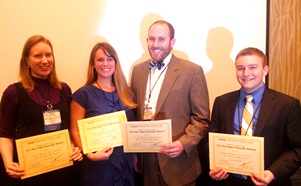An analysis of transit data conducted by a team of four CEE graduate students grabbed a top honor at the Transportation Research Board (TRB) annual meeting, held in Washington, D.C. January 13-17.
Gregory S. MacFarlane, Candace Brakewood, Jamie M. Fischer, and Alex Poznanski were recognized with an Honorable Mention by the TRB for their analysis of an issue that often stymies transportation planners: estimating the volume of transfer passengers in a multi-station public transit system. Their submission, “Monte Carlo Simulation for Transit Transfer Volumes" bested competition from other top colleges and the private sector. (The other Honorable Mention - for another problem - went to the IBM corporation.)
Their submission, “Monte Carlo Simulation for Transit Transfer Volumes" bested competition from other top colleges and the private sector. (The other Honorable Mention - for another problem - went to the IBM corporation.)
“This problem is about transportation demand forecasting – an analysis that takes into account economic data, like where people live and work – so engineers can build transportation systems that meet actual needs,” said MacFarlane, a doctoral student from Utah.
“Twenty years ago, we’d be looking at these problems by going out and counting cars or counting people. But now it makes much more sense to construct computer models using shared data.”
In the hypothetical rail system that the team was given to analyze, their analysis showed that “the most likely transfer volume range is from 50 to 73 passengers per direction, per day.”
But it wasn’t the numbers that impressed the TRB evaluators.
“They were more interested in the fact that we used open-source software to develop our analysis,” McFarlane said. “They even said they would require everyone to use open-source software in next year’s competition.”
All four collaborators agreed that the future of transportation planning will undoubtedly involve the use of open-source software, a tool that allows planners to develop analyses that can be easily shared by colleagues around the globe.
“The best thing about this is, really, anyone can download the repository of files that we used and repeat our results,” said Poznanski, a NYC native who is earning his masters in transportation. “Anyone can take our methods and models and apply them to their own system. And they can change them to meet their own requirements.”
Unlike their academic competitors, the CEE submission was produced without any faculty supervision.
“I think they [CEE faculty] thought it was a competition for students, so they told us about the competition, but they didn’t get involved,” said Brakewood, a Connecticut native whose doctoral research focuses on using technology to increase public transportation ridership. “I knew that it was a hypothetical model – it could have involved cars and highways – but when I saw that it involved trains, I was sold.”
